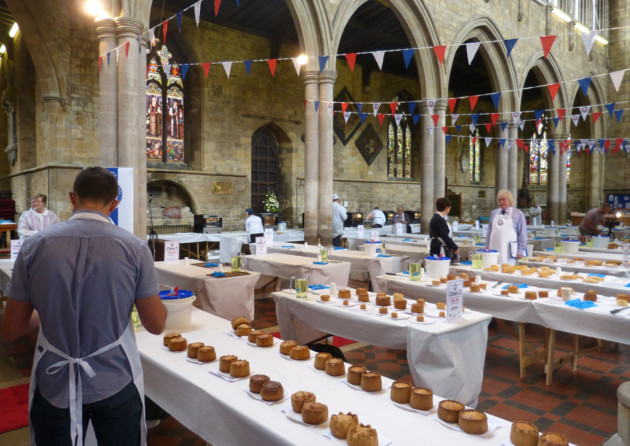The Great British pie trail
Knives and forks at the ready as we take a look at the long history behind the delicious range of traditional pies associated with different regions across Britain.
Pies have been worshipped in British culinary history since medieval times. So it’s fitting that the annual British Pie Awards take place each spring in a glorious medieval church, standing proud in the Leicestershire pork pie mecca of Melton Mowbray.
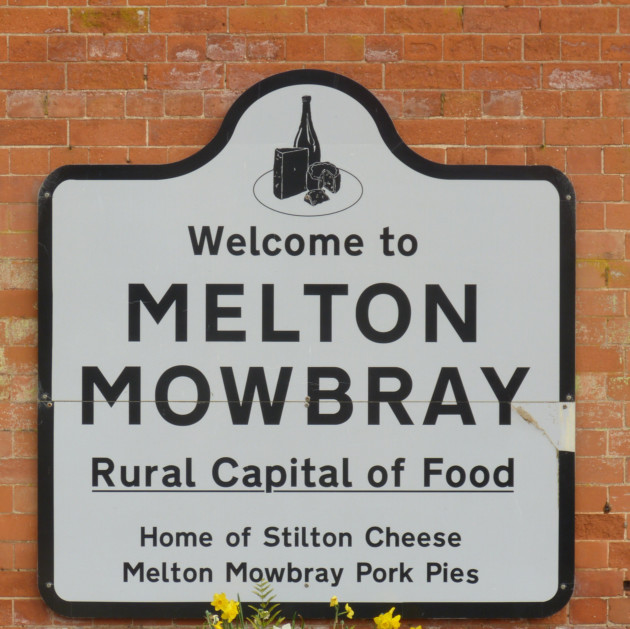
Station sign at Melton Mowbray makes it clear what the town is famous for! © Norman Miller
“It’s a cathedral of pies,” laughs head judge Ian Nielsen, as we stand in the vast nave of St Mary’s with a hungry horde of fellow judges poised to cut-and-nibble through 825 pies vying for honours in 19 categories. Classic meat and fish offerings beckon alongside crusty concoctions linked to traditional pie-munching locations, such as the Football Pie category – scooped several times by Morecambe FC, a tiny Lancashire club who may play their football in England’s fourth tier but rank as Premier League when it comes to pastry and filling!

Mousehole. © Visit Cornwall/Adam Gibbard
Melton Mowbray’s Carnegie Museum reveals how this pretty Norman market town began making pork pies as a complement to producing Stilton cheese. Whey left over from cheese-making was used to fatten pigs, prompting local bakers to pop this top quality pork – chopped, never minced – into sturdy hand-moulded casings to serve as perfect on-horseback meals for the area’s large fox-hunting fraternity. Seventeenth-century farm workers also took the pies into the fields, and by the late 19th century their renown saw consignments shipped to London and elsewhere as fast as they could be made.
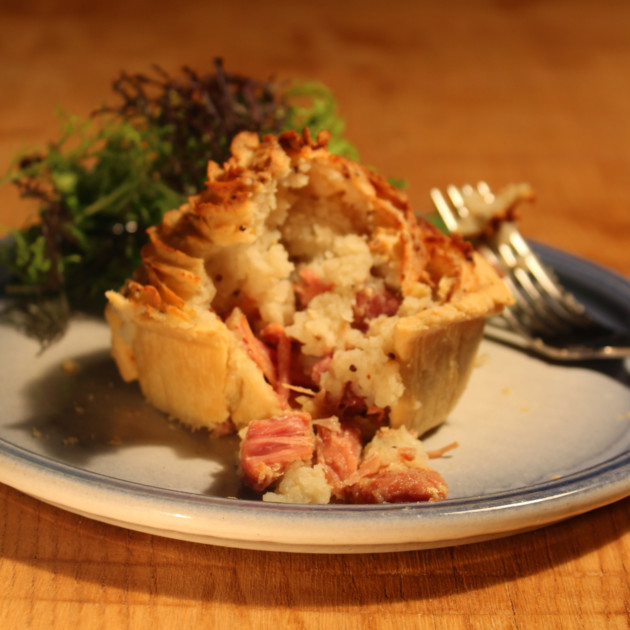
Fidget Pie. © Ludlow Food Centre
But Melton Mowbray’s porker is just one of a delicious panoply of historic baked beauties that provide edible geographical markers around the country. Take Cornwall’s eye-catching Stargazy Pie, cooked with a platoon of pilchards gazing up from the crust. This remarkable pie has roots in a Cornish folk tale from the picturesque fishing village of Mousehole. The story goes that just before one 17th-century Christmas, fisherman Tom Bawcock braved winter storms that had left the townsfolk starving and landed a huge haul of fish. When he returned his catch was baked into a giant celebratory pie, with pilchard heads left poking out as proof that the fish famine was over.
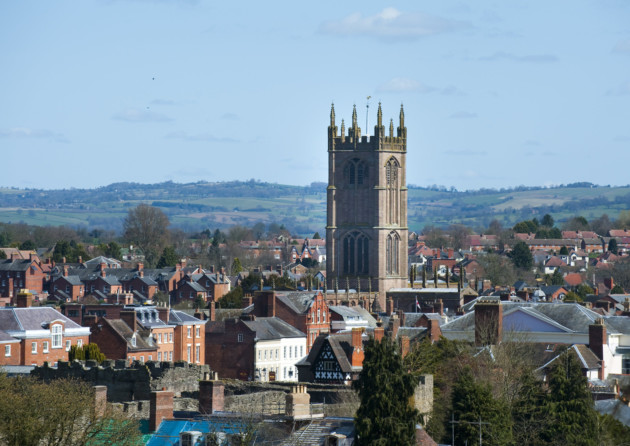
Ludlow, Shropshire. ©Mike Hayward
Today, Stargazy Pie is baked every year at places such as The Ship Inn in Mousehole on what is known as Tom Bawcock’s Eve on 23 December. The classic version contains seven kinds of fish, boiled potatoes, boiled eggs and white sauce, with the pokey-up pilchards serving a practical purpose, too, as oil from the heads enriches the pastry and moistens the pie.
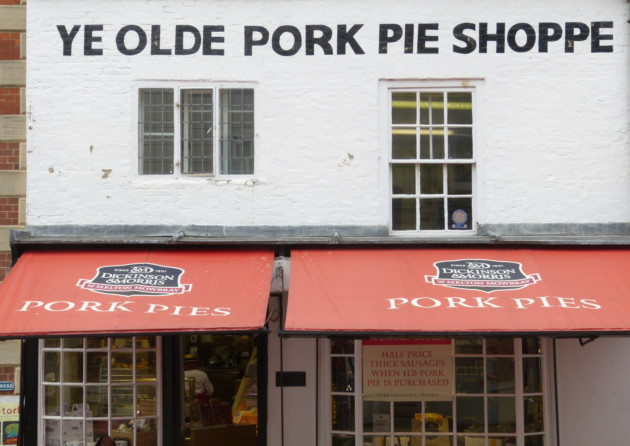
Famous Melton Mowbray pie shop. © Norman Miller
Another quirky classic is the Bedfordshire Clanger. This takes the idea of the pie as a portable meal an extra step by combining main course and dessert, with savoury ingredients at one end, sweet at the other. The most traditional combination sets pork alongside pear – and before you ask, two holes identify the meat end, three slits the pud! Novelist HE Bates wasn’t impressed after eating a Clanger he described as “hard as a hog’s back” but they can’t all have been that bad, given its name probably derives from a local dialect word ‘clang’, to eat voraciously. Of course, cramming two courses into one makes Clanger pies rather long and unwieldy – all too easy to drop, in fact. Hence, perhaps, the saying about dropping a clanger…
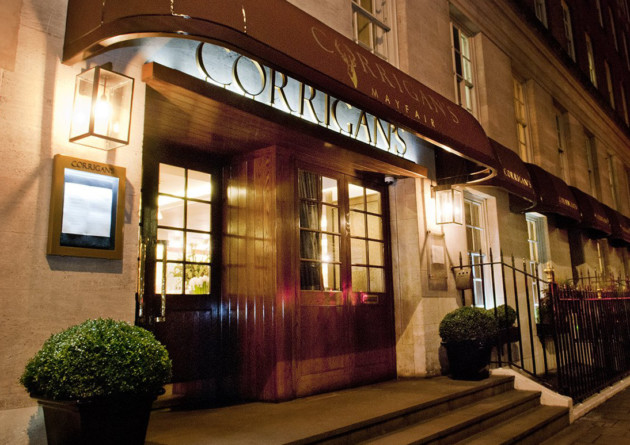
Mayfair’s Michelin-starred Corrigan’s restaurant
Another old pie with an unusual name is the gammon, apple and cider creation called Fidget Pie in Shropshire and Figit Pie in Yorkshire. The origin of the name is lost in 400 years of history but may be linked to its original five-sided shape – ‘fitched’ in local dialect. Fidget Pie enjoyed a renaissance when TV’s Hairy Bikers, Dave Myers and Si King, roared into the Shropshire foodie town of Ludlow a few years back and cooked one on the programme. Suddenly it was hip, and Ludlow Food Centre has sold over 10,000 since.
Today, pies are seen as proletarian nosh, but for centuries they were food for the elite just as much as the peasants. From Domesday times until the early 19th century, for example, East Anglia paid some of its levies to the crown with herring pies: one 13th-century chronicle lists Norwich sending Henry II an annual quota of 24 pies, each required to contain five herrings. The first recorded recipe for a pork pie is from the kitchen of Richard II in 1390, while Henry VI’s 1429 coronation featured a regal pie of “Partryche and Pecock”. In 1465 the installation feast for a new Archbishop of York saw guests scoff 5,500 venison pasties.
Venison may now be considered posh but the vast numbers of deer once roaming Britain made it something common folk enjoyed, too – even if the finest cuts went to the toffs while lower orders made do with so-called “Umble” Pie. Taking its name from the Norman French word nombles for deer offal, this probably underpins the modern-day expression for being put in your place by having to ‘eat humble pie’.
So why did the elite start turning noses up at pies? “The change began to happen during the Victorian era,” explains Tom Bridge, whose book Pie Society is the bible of the joys and history of British pies, including some of the more upmarket ones favoured by the aristocracy. “The cost of ingredients plus the hard work – it could take four to six cooks to make a pie over a 48-hour period – was one reason.”
Pie shops have became evocative fictional locations, too, from TV’s Blackadder and his beloved Mrs Miggins to Mrs Lovett’s cannibalistic outlet in Stephen Sondheim’s dark musical ‘Sweeney Todd’. Sondheim would doubtless appreciate medieval pie recipes calling the pastry casings ‘coffyns’ – which then simply meant basket or box rather than anything to do with death.
People were once put into British pies, mind you. The 16th and 17th centuries saw the rise of so-called Surprised Pyes – created for aristocratic banquets as ‘Lordy, look at that’ culinary entertainment. One gigantic 16th-century royal pie concealed a gaggle of musicians who began playing when the pie was cut, while the 17th-century’s small statured Jeffrey Hudson found gainful employment jumping out of pies at banquets to startle guests. Concealing live birds ready to burst forth from an outer pie case was another popular piece of showmanship, hence the “four and twenty blackbirds” from the nursery rhyme Sing a Song of Sixpence.
Some traditional British pies have now become rarities, such as Muggity Pie – still made by pie maestro Tom Bridge. “Muggity Pie is steak and cow heel – real Desperate Dan stuff,” he says. “Cow heel is a great source of gelatine that gives a wonderful flavour. But it’s rare today. Out of fashion.”
Whisky-infused grouse pie was once a regular on grand tables in Scotland during game season, starting on the ‘Glorious Twelfth’ of August, and traditionally served with rowan jelly. Today, you’re most likely to find it only from August to December at upmarket London restaurants such as the Michelin-starred Corrigan’s. “It’s a popular signature dish,” says Corrigan’s Tara Sura. Another traditional game bird recipe is pigeon pie, which one 1607 monastery recipe book suggested cooking with pork fat or (rather daringly) bitter limes. Today, your best bet to find it is in rural Devon.
With the boom in street foods, there has been renewed interest in pies – both classic and new-fangled. “We found flavours like sweet potato and feta, or spiced tomato and mushroom, are driving in a new consumer,” says Camilla Stephens of award-winning Sussex-based Higgedy Pies. Meanwhile, Britain’s largest pie producers, Pukka Pies, has been inspired by Midlands pie lovers to create a popular Balti Pie.
Pie-eyed punters are also taking matters into their own hands. The Pie Club at London pub The Windmill boasts 6,000 members, vying periodically to create a new Pie of the Month. Recent champs include a quails’ egg Breakfast Pie, plus mutton enlivened with fennel, cumin and coriander.
Back at Melton Mowbray’s ‘pie cathedral’, there’s time to chat to Reverend Kevin Ashby after a day’s judging at the British Pie Awards. He is quick to give his blessing to this classic British food. “We must have pies,” he says simply. “Stress can’t exist in the presence of a pie!”
Words: Norman Miller

